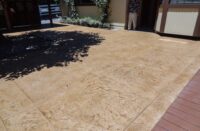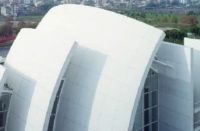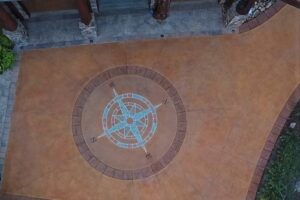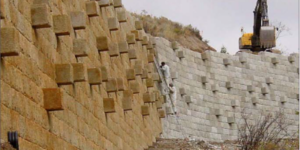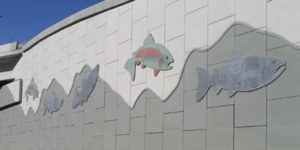 The purpose of the retaining wall remains unchanged — to hold back dirt — but decorative concrete offers a solution to improve the appearance of retaining walls.
The purpose of the retaining wall remains unchanged — to hold back dirt — but decorative concrete offers a solution to improve the appearance of retaining walls.
The concrete retaining wall has evolved from drab to fab. While retaining walls were once just utilitarian surfaces meant to hold back earth, they have also in recent years become aesthetic wonders. Even public highways have become decorative. Take the 8-mile retaining wall on the Pima Freeway in Scottsdale, Ariz. The wall, built by Scott System Inc. out of Denver, Colo., boasts desert-inspired designs, including 40-foot-tall prickly pear cactus and giant lizards 67 feet long.
 Another surprising example is the wall along Snoqualmie Pass over the Cascade Mountain range near Edmonds, Wash., where Turnstone Construction Inc. of Seattle, Wash., took a falling-down wall of stacked stone and turned it into a stunning mountain of concrete carved to look like a wall of natural granite.
Another surprising example is the wall along Snoqualmie Pass over the Cascade Mountain range near Edmonds, Wash., where Turnstone Construction Inc. of Seattle, Wash., took a falling-down wall of stacked stone and turned it into a stunning mountain of concrete carved to look like a wall of natural granite.
T he purpose of the retaining wall remains unchanged — to hold back dirt — but appearance has become a critical aspect of the wall. Companies specializing in decorative concrete are spicing up walls in both public and private settings.
he purpose of the retaining wall remains unchanged — to hold back dirt — but appearance has become a critical aspect of the wall. Companies specializing in decorative concrete are spicing up walls in both public and private settings.
Park City, Utah, is a resort town, known for skiing, picturesque mountains and multimillion-dollar homes, and these homeowners have taken to decorating their private retaining walls. “As one can imagine, these homeowners spare no expense creating spectacular landscaping as well as outdoor and curb appeal when it comes to their accommodations,” says Ron Petersen, president of Surface Imaging Inc. in Layton, Utah. “Many of the homes are built right into thickets of trees on unsteady slope.”
Petersen recently repaired and refinished a deteriorating retaining wall on one of these pricey homes. After a thorough pressure washing of the wall to remove dirt and debris, Petersen made structural and aesthetic repairs to restore the strength needed for proper functioning. Then he applied a thin coat of polymer concrete with a brown base to prepare the wall for staining.
 Petersen consulted with Steve Schmid, president of Stone Touch Inc. of Salt Lake City, before beginning the Park City project. Stone Touch integrated decorative patterns into the wall and applied an acid stain, then a sealer. “Many homeowners are not aware of all the new products and techniques that are available to resuscitate a failing or unsightly retaining wall,” Peterson notes. Local contractors often refer homeowners to Surface Imaging so they can get more than simple, undecorated retaining walls.
Petersen consulted with Steve Schmid, president of Stone Touch Inc. of Salt Lake City, before beginning the Park City project. Stone Touch integrated decorative patterns into the wall and applied an acid stain, then a sealer. “Many homeowners are not aware of all the new products and techniques that are available to resuscitate a failing or unsightly retaining wall,” Peterson notes. Local contractors often refer homeowners to Surface Imaging so they can get more than simple, undecorated retaining walls.
The earth itself can become a potential hazard for those living in this stylish ambiance surrounded by rugged terrain. While the retaining walls have become ornamental beauties, the functional quality of the product is not being compromised. The walls — though prettied up on the outside — are lasting longer thanks to routine maintenance and improved bricks that have come on the market lately.
 One of the techniques used for creating decorative surfaces is sprayed concrete. “We use compressed air to shoot mortar or concrete through a hose and nozzle onto a surface,” explains John Fulford, owner of Turnstone. “The concrete is sprayed in a vertical manner onto an armature and, like magic, it sticks to the surface and stacks right up. No need to pour.”
One of the techniques used for creating decorative surfaces is sprayed concrete. “We use compressed air to shoot mortar or concrete through a hose and nozzle onto a surface,” explains John Fulford, owner of Turnstone. “The concrete is sprayed in a vertical manner onto an armature and, like magic, it sticks to the surface and stacks right up. No need to pour.”
For the granite wall job, Fulford’s team sprayed the retaining wall with shotcrete to buttress it. Then they carved it to look like the road was cut out of granite rock. Underneath the decorative granite-like surface is reinforced steel and high-strength concrete. The color comes from acrylic stain. “We used antigraffiti sealer, trowels, brushes and different hooks to create the decorative look,” says Fulford. “The mayor of Edmonds (Wash.) was so pleased with the result, he came out and gave the wall his blessing.”
 The structural material underneath the decorative retaining wall can include steel, timber, brick, concrete blocks and even reinforced soil. The surface itself is concrete carved or stained into beauty. Sometimes it’s created on the spot. Other times, manufactured decorative surfaces are applied to the finished retaining wall.
The structural material underneath the decorative retaining wall can include steel, timber, brick, concrete blocks and even reinforced soil. The surface itself is concrete carved or stained into beauty. Sometimes it’s created on the spot. Other times, manufactured decorative surfaces are applied to the finished retaining wall.
Scott System offers complete design services, including construction, consultation, job site assistance and graphics or sculpting. “We offer concrete contractors a method to create textures and patterns,” says Dana Johnston, marketing director at Scott System. “We created a number of standard and custom patterns for the Scottsdale wall.”
 Simstone Inc. of Shakopee, Minn., provides colors and stamps for decorative concrete that look like natural rock. “We use a dry mixture to make segmental retaining wall units,” says sales director Ray Clark. “We integrate color during the manufacturing process. The decorative blocks are made in a machine that produces a high-vibration frequency to form the zero-slump concrete mix into strong blocks with a natural stone look.”
Simstone Inc. of Shakopee, Minn., provides colors and stamps for decorative concrete that look like natural rock. “We use a dry mixture to make segmental retaining wall units,” says sales director Ray Clark. “We integrate color during the manufacturing process. The decorative blocks are made in a machine that produces a high-vibration frequency to form the zero-slump concrete mix into strong blocks with a natural stone look.”
Simstone also trains contractors who do a lot of flat concrete work but want to learn how to use molded blocks to install decorative walls. “Some contractors are moving into the decorative wall business because their regular business is drying up,” says Clark. “Interest in decorative retaining walls is growing, since consumers are seeking new fashions in concrete work.”
